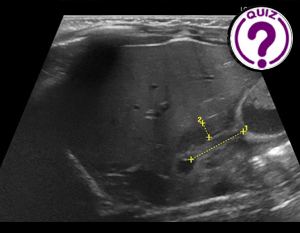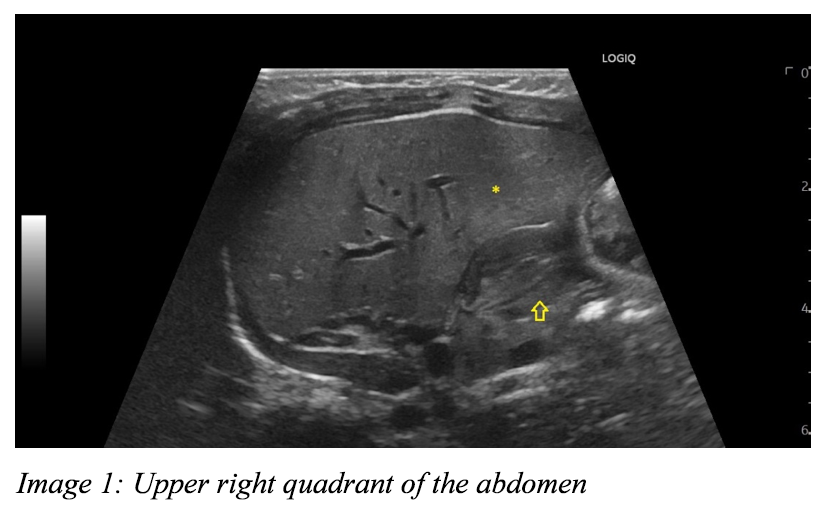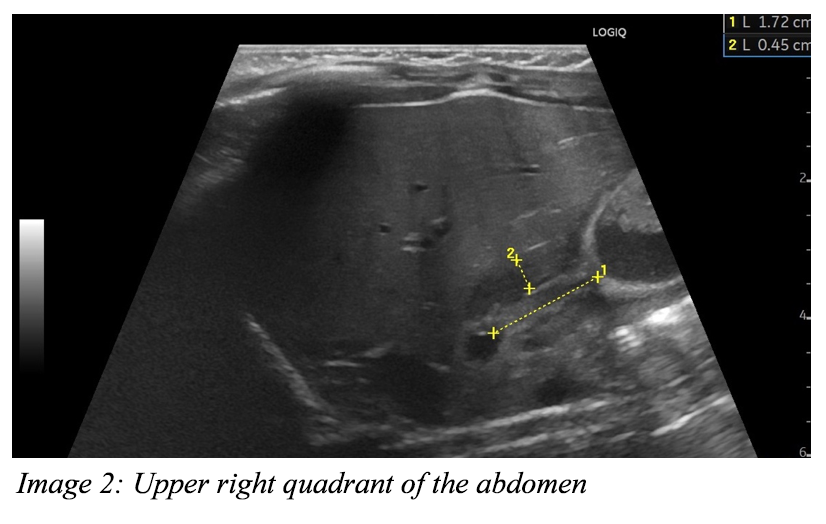
Publications Committee Chair Adrian Săftoiu
June 9, 2023
Case of the Month August 2023 – Importance of contrast enhanced ultrasound in assessment of the uterus
August 1, 2023Camilla Palmquist Frykman1* and Ditte Dencker1
1 Dept. Of Radiology, Copenhagen University Hospital, Rigshospitalet, Denmark; camilla.palmquist.frykman.01@regionh.dk
* Correspondence: camilla.palmquist.frykman.01@regionh.dk
Clinical history
A 5-week-old girl born at normal gestational age was referred to the pediatric emergency department at our hospital after 10 days of abdominal pain and frequent explosive vomiting, not always related to meals. The girl had a weight loss of 300g in six days. She was breastfed unproblematically, had a normal appetite, and normal stools. Medical examination did not reveal abdominal pain.
Images
Quiz-summary
0 of 4 questions completed
Questions:
- 1
- 2
- 3
- 4
Information
View the July Case below, answer the question and then click check >
You have already completed the quiz before. Hence you can not start it again.
Quiz is loading...
You must sign in or sign up to start the quiz.
You have to finish following quiz, to start this quiz:
Results
0 of 4 questions answered correctly
Your time:
Time has elapsed
You have reached 0 of 0 points, (0)
Categories
- Not categorized 0%
- 1
- 2
- 3
- 4
- Answered
- Review
-
Question 1 of 4
1. Question
Question 1: Please consider the structures seen on image 1, especially the structure marked by a yellow arrow.
What do the asterisk and the arrow represent, respectively?Correct
CORRECT ANSWER EXPLAINED BELOW Correct answer to Q1 is: Liver and pylorus
Incorrect
CORRECT ANSWER EXPLAINED BELOW Correct answer to Q1 is: Liver and pylorus
-
Question 2 of 4
2. Question
Question 2: What are the ultrasound findings on image 2?
Correct
CORRECT ANSWER EXPLAINED BELOW Correct answer to Q2 is: Pyloric muscle hypertrophy and pathologic elongation of the pylorus
Incorrect
CORRECT ANSWER EXPLAINED BELOW Correct answer to Q2 is: Pyloric muscle hypertrophy and pathologic elongation of the pylorus
-
Question 3 of 4
3. Question
Question 3: How is infantile hypertrophic pyloric stenosis treated?
Correct
CORRECT ANSWER EXPLAINED BELOW Correct answer to Q3 is: Surgically with a longitudinal pyelomyotomy
The girl was treated with a pyelomyotomy and supplemental oral antacida. In the following months she was still vomiting, but only a few times a day and no longer explosively.
Discussion
Infantile hypertrophic pyloric stenosis (IHPS) is a common condition in neonates involving narrowing of the pylorus. In Western countries its prevalence is 2 in 1,000 live births (1). The hypertrophy of the pyloric muscle leads to decreased gastric outlet and thus projectile postprandial vomiting. Symptoms often show when the infant is 3-6 weeks old. IHPS can occur as an isolated phenomenon or can be linked with congenital malformations or genetic syndromes (2). Ultrasound is the modality of choice with a sensitivity of 97% and specificity of 100% (3).
Diagnosis is based on a) pyloric muscle thickness/diameter >3 mm on a transverse image (normally <2 mm), b) pyloric length/longitudinal measurement >15-17 mm, and/or c) pyloric transverse diameter >13 mm, with pyloric muscle thickness being the most sensitive finding (4).
IHPS is treated surgically with pyloromyotomy, where the pyloric muscle is incised longitudinally down to the submucosa.
Incorrect
CORRECT ANSWER EXPLAINED BELOW Correct answer to Q3 is: Surgically with a longitudinal pyelomyotomy
The girl was treated with a pyelomyotomy and supplemental oral antacida. In the following months she was still vomiting, but only a few times a day and no longer explosively.
Discussion
Infantile hypertrophic pyloric stenosis (IHPS) is a common condition in neonates involving narrowing of the pylorus. In Western countries its prevalence is 2 in 1,000 live births (1). The hypertrophy of the pyloric muscle leads to decreased gastric outlet and thus projectile postprandial vomiting. Symptoms often show when the infant is 3-6 weeks old. IHPS can occur as an isolated phenomenon or can be linked with congenital malformations or genetic syndromes (2). Ultrasound is the modality of choice with a sensitivity of 97% and specificity of 100% (3).
Diagnosis is based on a) pyloric muscle thickness/diameter >3 mm on a transverse image (normally <2 mm), b) pyloric length/longitudinal measurement >15-17 mm, and/or c) pyloric transverse diameter >13 mm, with pyloric muscle thickness being the most sensitive finding (4).
IHPS is treated surgically with pyloromyotomy, where the pyloric muscle is incised longitudinally down to the submucosa.
-
Question 4 of 4
4. Question
Question 4: What are the ultrasound findings on video 1?
Correct
CORRECT ANSWER EXPLAINED BELOW Correct answer to Q4 is: Exaggerated ventricle peristalsis with no opening of the pylorus.
Additional Discussion:
Due to hypertrophy of the pyloric muscle emptying of the ventricle is obstructed. The ventricle peristalsis is exaggerated in attemt to propel the bolus further.
Conclusion
Infantile hypertrophic pyloric stenosis is a common condition among newborns with symptoms of postprandial projectile vomiting typically arising around 3-6 weeks of age. Ultrasound is the diagnostic modality of choice due to its high sensitivity and specificity. Pyelomyotomy is the curative treatment of the condition.
Conflicts of interest
“The authors declare no conflict of interest.”
References
- MacMahon, B. The continuing enigma of pyloric stenosis in infancy, a review. Epidemiology. 2006;17(2):195-201.
- Peeters B. et al. Nat. Rev. Gastroenterol. Hepatol. 2012;9, 646–660.
- Godbole P, Sprigg A, Dickson J, Lin P. Ultrasound Compared with Clinical Examination in Infantile Hypertrophic Pyloric Stenosis. Arch Dis Child. 1996;75(4):335-7.
- Blumhagen J D, Maclin L, Krauter D, Rosenbaum DM, Weinberger E. AJR. Sonographic diagnosis of hypertrophic pyloric stenosis. 1988;150(6), 1367-1370
Incorrect
CORRECT ANSWER EXPLAINED BELOW Correct answer to Q4 is: Exaggerated ventricle peristalsis with no opening of the pylorus.
Additional Discussion:
Due to hypertrophy of the pyloric muscle emptying of the ventricle is obstructed. The ventricle peristalsis is exaggerated in attemt to propel the bolus further.
Conclusion
Infantile hypertrophic pyloric stenosis is a common condition among newborns with symptoms of postprandial projectile vomiting typically arising around 3-6 weeks of age. Ultrasound is the diagnostic modality of choice due to its high sensitivity and specificity. Pyelomyotomy is the curative treatment of the condition.
Conflicts of interest
“The authors declare no conflict of interest.”
References
- MacMahon, B. The continuing enigma of pyloric stenosis in infancy, a review. Epidemiology. 2006;17(2):195-201.
- Peeters B. et al. Nat. Rev. Gastroenterol. Hepatol. 2012;9, 646–660.
- Godbole P, Sprigg A, Dickson J, Lin P. Ultrasound Compared with Clinical Examination in Infantile Hypertrophic Pyloric Stenosis. Arch Dis Child. 1996;75(4):335-7.
- Blumhagen J D, Maclin L, Krauter D, Rosenbaum DM, Weinberger E. AJR. Sonographic diagnosis of hypertrophic pyloric stenosis. 1988;150(6), 1367-1370



